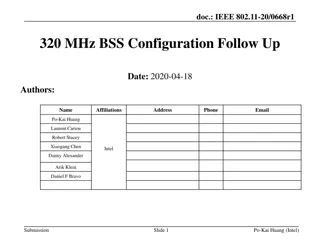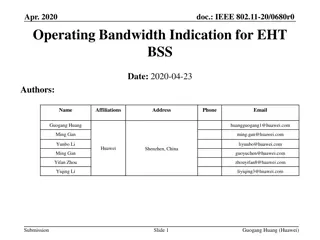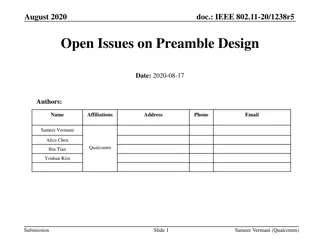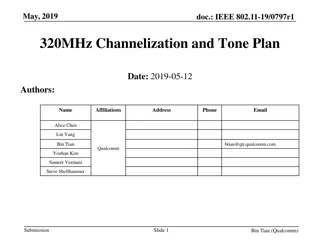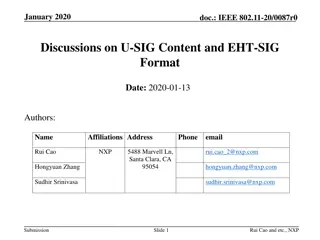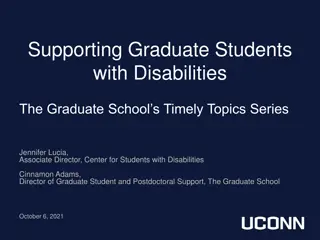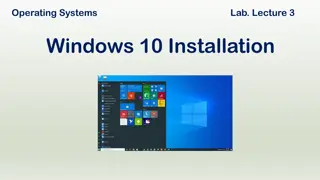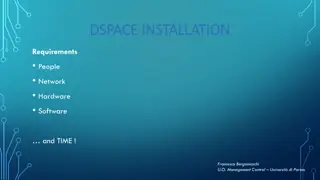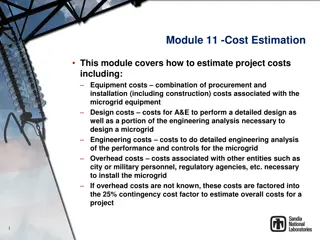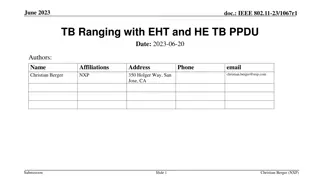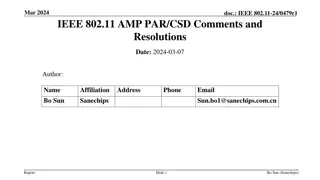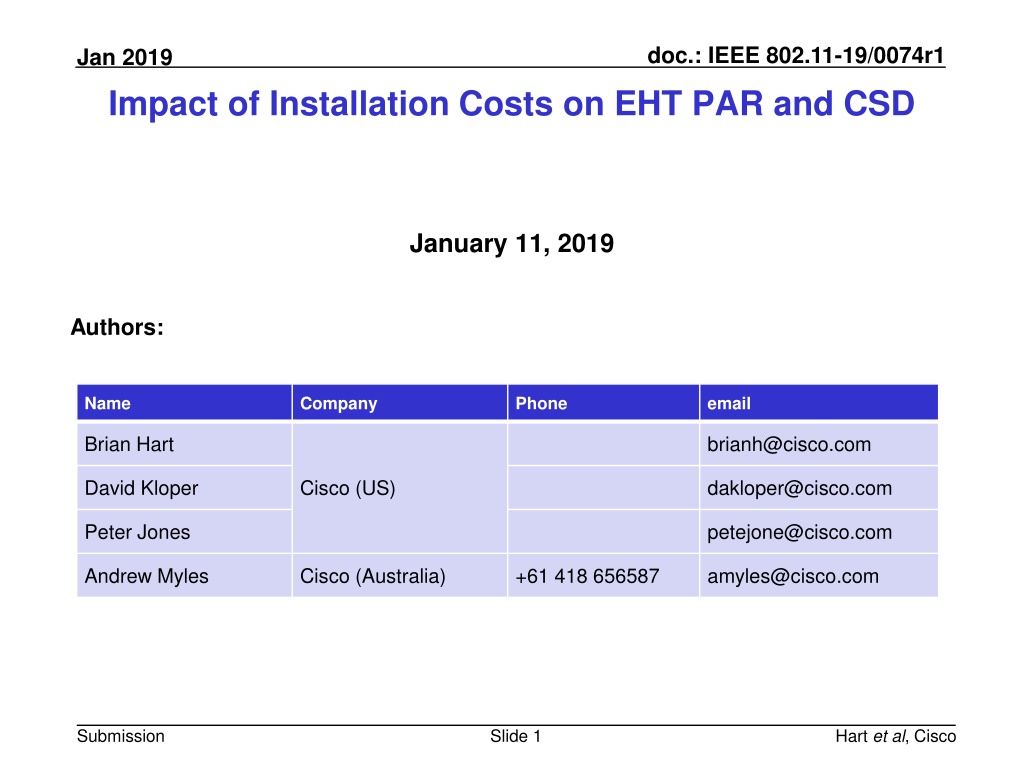
Impact of Installation Costs on EHT PAR and CSD Analysis
Explore the influence of installation costs on EHT PAR and CSD in IEEE 802.11-19/0074r1. The study examines the implications of using different cabling structures and proposes solutions to streamline backhaul requirements for triband APs. Discover industry recommendations and best practices for cabling future 802.11 APs to enhance network performance and efficiency.
Download Presentation

Please find below an Image/Link to download the presentation.
The content on the website is provided AS IS for your information and personal use only. It may not be sold, licensed, or shared on other websites without obtaining consent from the author. If you encounter any issues during the download, it is possible that the publisher has removed the file from their server.
You are allowed to download the files provided on this website for personal or commercial use, subject to the condition that they are used lawfully. All files are the property of their respective owners.
The content on the website is provided AS IS for your information and personal use only. It may not be sold, licensed, or shared on other websites without obtaining consent from the author.
E N D
Presentation Transcript
doc.: IEEE 802.11-19/0074r1 Jan 2019 Impact of Installation Costs on EHT PAR and CSD January 11, 2019 Authors: Name Company Phone email Brian Hart brianh@cisco.com David Kloper Cisco (US) dakloper@cisco.com Peter Jones petejone@cisco.com Andrew Myles Cisco (Australia) +61 418 656587 amyles@cisco.com Submission Slide 1 Hart et al, Cisco
doc.: IEEE 802.11-19/0074r1 Jan 2019 EHT CSD should properly account for installation costs of a 20 Gbps AP The draft PAR (1231r1) & CSD (1233r1) reports supporting a maximum throughput of at least 18/30 Gbps and The proposed amendment has no known impact on installation costs. Situation For many years, industry has recommended that venues pull dual cat6a cables, supporting 20 Gbps full duplex max Requiring different cabling structures (e.g., >2 cables, fiber, unfamiliar cable types, etc) complicates installation, and creates barriers to adoption of EHT Complication For traditional AP use cases, the EHT PAR and CSD should explicitly limit backhaul requirements for a triband AP to 2x10Gbps (2xCat6a) Ethernet max Solution Submission Slide 2 Hart et al, Cisco
doc.: IEEE 802.11-19/0074r1 Jan 2019 Cabling Variability Cabling Variability Submission 25
Updated doc.: IEEE 802.11-19/0074r1 Jan 2019 A lot of installs use cat5e or cat6, and will continue to do so 2014 installed base 90+% Cat 5e/6 2018 update 130 135 million outlets per year An est. 60% are new installations 1.4 billion installed base in 2014 1.6 billion in 2017. Source: BSRIA NBASE-T webinar https://www.nbaset.org/wp-content/uploads/2018/10/WebinarBSRIA_Oct2018_Final.pdf Submission IEEE 802.3 NEA - Cabling for future 802.11 APs 16
doc.: IEEE 802.11-19/0074r1 Jan 2019 A lot of installs use cat5e or cat6, and will continue to do so [1] Submission IEEE 802.3 NEA - Cabling for future 802.11 APs 16
doc.: IEEE 802.11-19/0074r1 Jan 2019 Cabling Best Practice Cabling Best Practice Submission 25
Updated doc.: IEEE 802.11-19/0074r1 Jan 2019 TIA-162-A Telecommunications Cabling Guidelines for Wireless Access Points www.ieee802.org/3/bq/public/nov13/larsen_3bq_01_1113.pdf Submission IEEE 802.3 NEA - Cabling for future 802.11 APs 26
Updated doc.: IEEE 802.11-19/0074r1 Jan 2019 Industry recommendation examples (Panduit, Leviton) http://panduitblog.com/2015/06/16/enterprise/cabling-infrastructure-wireless-access-points/ http://panduitblog.com/2015/06/16/enterprise/cabling-infrastructure-wireless-access-points/ Cisco San Jose example https://www.leviton.com/en/docs/Leviton_3KeyRecsForCablingTo802.11acWirelessAccessPoints.pdf https://www.leviton.com/en/docs/Leviton_3KeyRecsForCablingTo802.11acWirelessAccessPoints.pdf Submission 26
Updated doc.: IEEE 802.11-19/0074r1 Jan 2019 Impact of EHT requiring new cabling practices EHT will not succeed if it expects the industry to change basic installation practices. Buildings are designed so wiring closets are within a 100m Manhattan distance of everywhere on the floor 25GBASE-T is defined for 30m of Cat 8 (data center use case) Cat7/7a/8 require new design and installation practices. Bigger cables, lower bend radius, etc., increase the cost of the cabling system. TIA-162-A does allow for MMF OM3 fiber, but this is not common. 25GBASE-SR OM3 reach is 70M (10GBASE-SR OM3 is 300m), and power must be separately delivered. Copper/fiber composite cable (powered fiber cable) is not commonly deployed in this environment or best practice. Major Barrier to Adoption Slide 9 Submission Hart et al, Cisco
doc.: IEEE 802.11-19/0074r1 Jan 2019 Proposed PAR and CSD Changes Proposed PAR and CSD Changes Submission 25
doc.: IEEE 802.11-19/0074r1 Jan 2019 Proposed PAR edits: make it explicit that backhaul requirements are benign 30 Gbps is a source of concern, especially since a typical triband AP could increase this by 56% 5.2b Scope of the project: This amendment defines standardized modifications to both the 802.11 physical layers (PHY) and the 802.11 Medium Access Control Layer (MAC) that enable modes of operation capable of supporting a maximum throughput of at least 18/30 Gbps, as measured at the MAC data service access point (SAP), with carrier frequency operation between 1 and 7.125 GHz while ensuring backward compatibility and coexistence with legacy IEEE802.11 devices in the 2.4 and 5 GHz unlicensed bands, and with IEEE802.11ax devices in the 6 GHz band. 8.1 Scope of the project: Item 5.2b: The focus of this amendment is on: WLAN indoor and outdoor operation in the 2.4 GHz, 5 GHz and 6GHz frequency bands. Outdoor operation is limited to stationary and pedestrian speeds WLAN operation that does not require AP products, which might include 2.4, 5 and 6 GHz APs, to need more than dual 10 Gbps full duplex for wired backhaul. Submission Slide 11 Hart et al, Cisco
doc.: IEEE 802.11-19/0074r1 Jan 2019 Proposed CSD edits: acknowledge cabling impact Consideration of installation costs. Industry has recommended dual Cat6a cabling for APs for many years. For venues following this advice, tThe proposed amendment has no known impact on installation costs even for high end EHT APs. In many other cases, such as lower end APs compliant with EHT or networks designed such that the bulk of the traffic originates or terminates at end-points cohosted with STAs, the proposed amendment is not expected to impact installation costs either. In some cases, new cabling infrastructure is required for optimum EHT AP performance. The cabling cost is balanced and comparable to the cost of an initial 802.11 AP installation. Submission Slide 12 Hart et al, Cisco
doc.: IEEE 802.11-19/0074r1 Jan 2019 Strawpoll Do you support making a change to the PAR and CSD as per Slides 11 and 12? Y/ N /A? Submission Slide 13 Hart et al, Cisco
doc.: IEEE 802.11-19/0074r1 Jan 2019 Backup Submission Slide 14 Hart et al, Cisco
doc.: IEEE 802.11-19/0074r1 Jan 2019 References [1] Peter Jones, "802.3 NEA Future AP Cabling", Aug 2018 Submission Slide 15 Hart et al, Cisco
doc.: IEEE 802.11-19/0074r1 Jan 2019 No change to operational costs, since power and heat constrain the AP s feature set There is a trade-off between AP size (aesthetics), environmental sealing, passive/active cooling, and features. Power drives heat APs are predominately passively cooled Heat dissipation need drives physical size Assuming historical patterns continue, then size, sealing and passive cooling are primary considerations, and they define a maximum size and power envelope for high-end APs: Looking at 3 major brand 802.11ac Wave 2 APs Max Ethernet rates: 2 x 2.5Gb/s, 1 x 5Gb/s Max Power draw: average is 23.54W (max 25.5W) Area average: 73in2 (max 79in2) Inclusion of additional features (number of bands, number of transceivers and bandwidth per band, wired speed) in top of the line enterprise APs relies principally upon improvements to component efficiency. Submission Slide 16 Hart et al, Cisco
doc.: IEEE 802.11-19/0074r1 Jan 2019 CSD Operation costs: no edits needed Consideration of operational costs (e.g., energy consumption). There are billions of WLAN systems in operation around the world. WLAN systems are recognized to provide a total cost of ownership (TCO) that provides a significant operation cost benefits. This amendment is not expected to change today s operation costs. Agreed. Based on historical patterns, power consumption will not markedly change Submission Slide 17 Hart et al, Cisco


